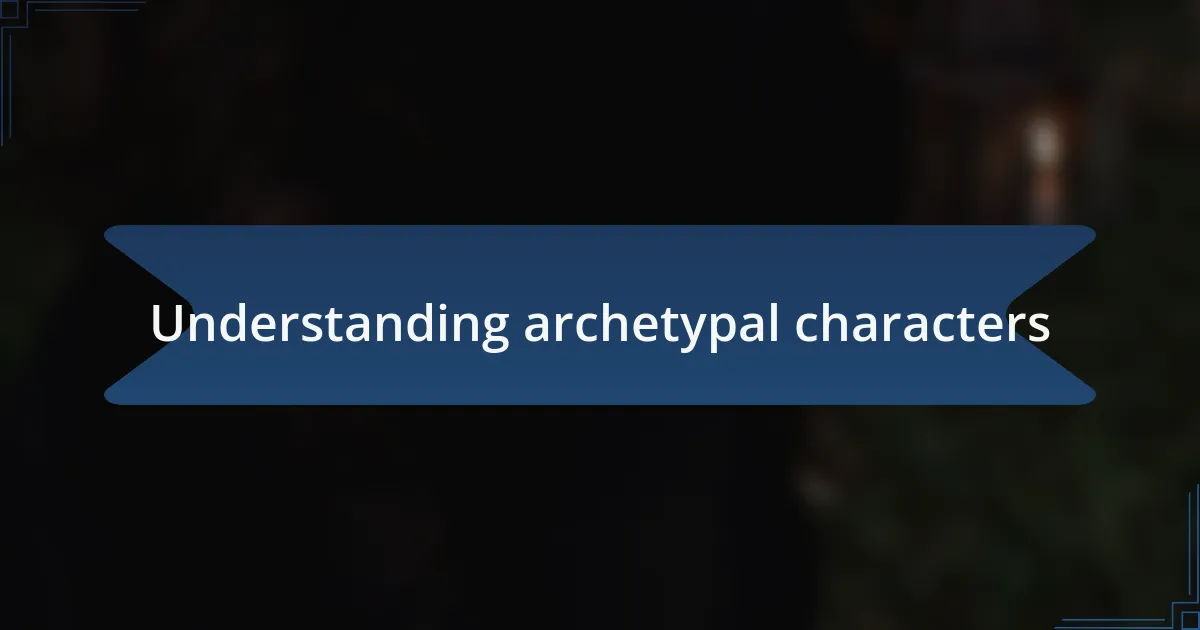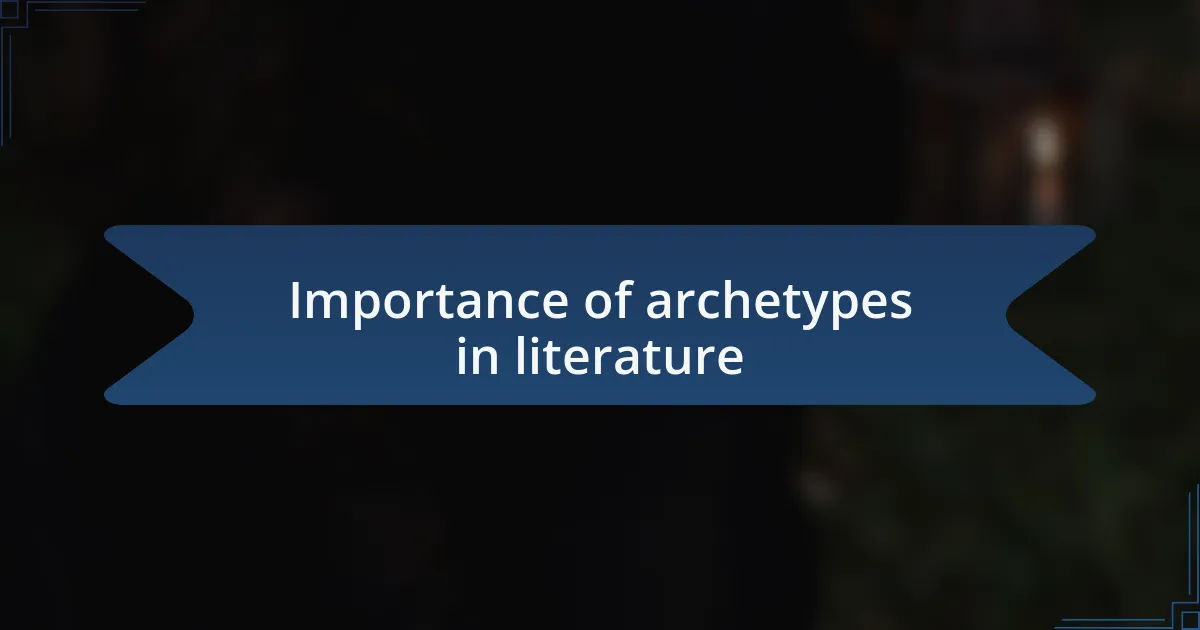Key takeaways:
- Archetypal characters in literature, such as the hero, mentor, and villain, reflect universal human experiences and emotions.
- Agatha Christie’s narratives utilize archetypes to enhance storytelling, shape character development, and provoke readers’ reflections on morality and society.
- Hercule Poirot represents order and logic, while Miss Marple exemplifies keen observation and compassion, both offering insights into human nature and problem-solving.

Understanding archetypal characters
Archetypal characters serve as universal symbols that resonate across different stories and cultures. For instance, the “hero” often embarks on a journey, facing trials that ultimately lead to personal growth. I remember reading a classic Agatha Christie novel where the detective resembled the archetypal hero—his determination to uncover the truth mirrored our own quests in life, making the story all the more compelling.
When we think of these roles, it’s fascinating how they reflect our own identities. Have you ever seen a piece of yourself in the “mentor” character, guiding others through challenges? I’ve found that those moments of recognition can spark a deeper understanding of our motivations and relationships with others, illuminating the paths we take in our own lives.
Engaging with these archetypes can evoke a range of emotions, from nostalgia to a sense of adventure. For example, reading about the “trickster” character often reminds me of the unpredictable twists in my own stories. Aren’t those the moments that challenge our perceptions and encourage us to embrace life’s complexities? Understanding these characters not only enriches our reading experience but also invites us to explore our roles within the grand narrative of life.

Importance of archetypes in literature
Archetypes in literature play a crucial role in shaping narratives, serving as a framework that guides character development and plot progression. When I delve into a story, I often find myself drawn to the “villain,” a character who embodies not just evil, but also the complexities of human nature. It makes me wonder—can we ever truly label someone as purely good or bad? This duality resonates through Christie’s works, where even the most villainous figures often evoke a degree of sympathy.
Moreover, these archetypes create a familiar landscape that allows readers to navigate intricate themes with ease. I recall a time while reading “Murder on the Orient Express” when I felt like I was piecing together a puzzle with Poirot. Each character type added a unique layer, and it struck me how their archetypal roles helped convey the nuances of justice and morality. Isn’t it intriguing how such frameworks can elevate storytelling beyond mere entertainment to a reflection on societal values?
Finally, archetypes foster connections between readers and characters. I’ve often found myself empathizing with the “innocent” character struggling against overwhelming odds. Their journey encourages us to reflect on our own lives—are we not all in search of vindication or understanding? This interplay between archetype and personal experience deepens our engagement with literature, enriching our understanding of ourselves and the world around us.
Overview of Agatha Christie’s works
Agatha Christie’s works are a treasure trove of mystery, intricately woven plots, and unforgettable characters. With over 66 novels to her name, including classics like “The Murder of Roger Ackroyd” and “Death on the Nile,” Christie crafted narratives that not only entertained but also challenged readers to engage in the search for truth. I remember the thrill of encountering clues alongside her detectives, feeling as though I, too, was part of the investigative journey.
What stands out to me is Christie’s remarkable ability to construct diverse character roles, each serving a specific purpose in solving the mystery. For instance, I often reflect on the role of the unreliable narrator, which she employed in several stories. It makes me ponder: how can we trust our perceptions when characters manipulate our expectations? This question is particularly evident in “And Then There Were None,” where every character’s secrets leave us guessing until the very end.
Christie’s influence is not just in her storytelling but also in how she shaped the genre of detective fiction. I indeed feel a sense of connection with her iconic detectives, particularly Hercule Poirot and Miss Marple, who embody traits of intellect and intuition. Their archetypal presence in her narratives invites readers to reflect on their own problem-solving methods—what clues do we ignore in our lives? As I engage with her works, I realize that Christie’s legacy is more than just captivating mysteries; it’s an invitation to examine the very nature of human behavior and morality through the lens of archetypal roles.
Common archetypes in Christie’s novels
The characters in Christie’s novels often fit into distinct archetypes that enhance the narrative’s complexity. Take, for instance, the “gentleman detective.” Hercule Poirot represents this archetype perfectly—he combines intellect with a unique sense of order and a penchant for psychological insight. I can vividly recall my fascination with Poirot’s meticulous nature; it made me wonder how much those little details matter in our own lives.
Another common archetype is the “damsel in distress.” While it may seem cliché, Christie revitalizes this role by giving depth and agency to her female characters, like the determined girl-next-door who often surprises everyone with her bravery. I remember feeling a sense of triumph when a seemingly vulnerable character stepped up to reveal a critical piece of the puzzle; it challenges the stereotype and invites us to reconsider our initial impressions of people.
Then there’s the “red herring”—characters intentionally designed to mislead both detectives and readers alike. I find these characters fascinating because they mirror real-life complexities; we often misjudge people based on incomplete information. I can’t help but reflect on my own experiences in friendships—how often have I been surprised when someone’s true nature emerged after I made assumptions based on first impressions? This interplay of archetypes and misdirection adds a rich layer to Christie’s storytelling, inviting readers to explore beyond the obvious.
Analyzing Hercule Poirot’s role
Hercule Poirot serves not only as a detective but as a symbol of order in a chaotic world. His obsessive attention to detail and insistence on method perfectly illustrate the importance of logical reasoning in solving problems. I often find myself reflecting on the idea that perhaps we all need a bit of Poirot’s precision in our daily lives; it’s quite striking how sometimes, it’s the smallest details that lead to the biggest breakthroughs.
Poirot’s unique blend of confidence and vulnerability makes him a fascinating character. Beneath his polished exterior lies a deep-seated loneliness that resonates with many of us. In my own life, I’ve experienced moments of isolation despite outward success, reminding me that brilliance can sometimes feel like a burden rather than a blessing. How often do we overlook the internal struggles of those who seem to have it all together?
What truly sets Poirot apart is his psychological insight; he doesn’t just solve crimes, he understands people. His conversations often reveal truths about human nature that we might prefer to ignore. I once had a conversation with a close friend that felt like a Poirot moment—when we unravelled an unspoken conflict lurking beneath the surface. I wonder if, like Poirot, we could better navigate our relationships by simply pausing to listen and observe more closely.
Exploring Miss Marple’s character traits
Miss Marple embodies the archetype of the astute observer, often drawing on her keen understanding of human nature. I find her ability to glean crucial insights from the seemingly mundane details of village life both inspiring and relatable. It’s fascinating how her quiet demeanor allows her to be overlooked, yet it’s precisely this very trait that gives her the advantage; sometimes, being underestimated can be a secret strength.
Another striking characteristic of Miss Marple is her unwavering compassion, as she deeply empathizes with the plight of others. I once encountered a situation where I too felt the weight of someone else’s struggles; sometimes, just listening can make a world of difference. This emotional connection she fosters serves as a reminder that understanding those around us can illuminate the murkiness of crime and mistrust. Have you ever learned something profound simply by paying attention to someone’s story?
Miss Marple’s resourcefulness is truly remarkable; she uses her extensive life experiences to crack cases that baffle even seasoned detectives. I think back to moments in my life where my background shaped my perspective on challenges; there’s a wisdom that comes with age that I believe we sometimes take for granted. Watching her navigate complex situations with such finesse prompts me to consider how our own histories inform our approaches to problems. Isn’t it intriguing how our past can light the way to solutions?